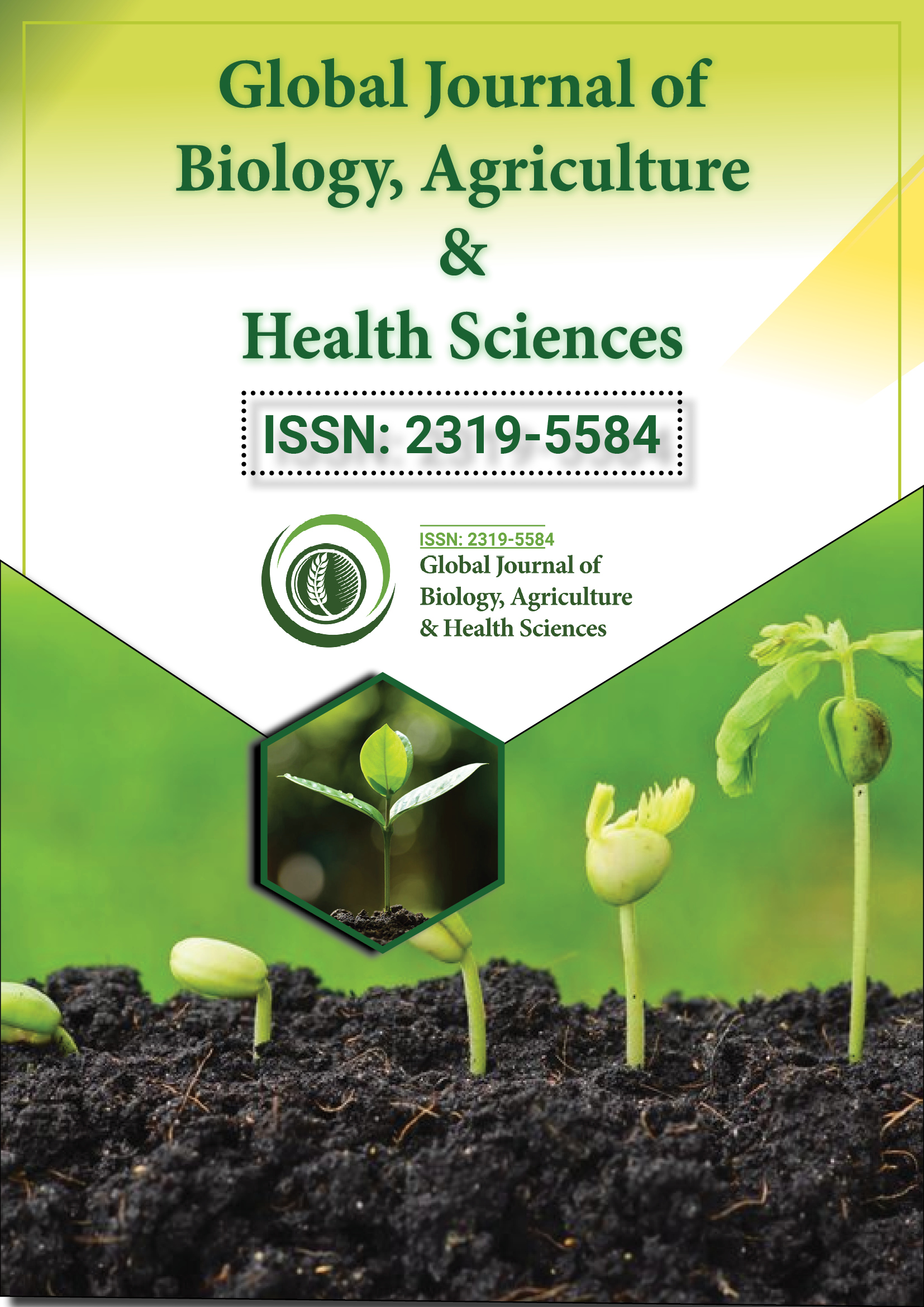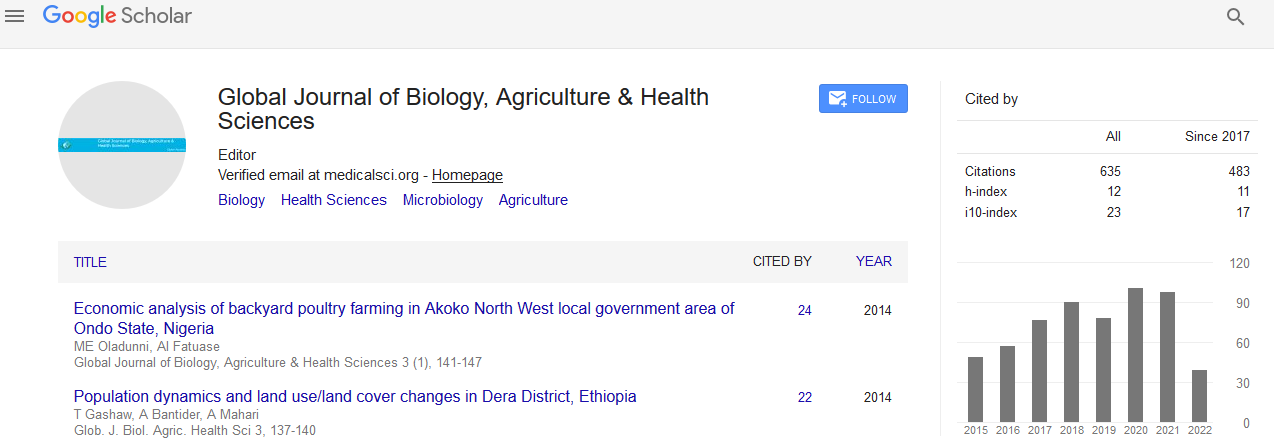Indexed In
- Euro Pub
- Google Scholar
Useful Links
Share This Page
Journal Flyer

Open Access Journals
- Agri and Aquaculture
- Biochemistry
- Bioinformatics & Systems Biology
- Business & Management
- Chemistry
- Clinical Sciences
- Engineering
- Food & Nutrition
- General Science
- Genetics & Molecular Biology
- Immunology & Microbiology
- Medical Sciences
- Neuroscience & Psychology
- Nursing & Health Care
- Pharmaceutical Sciences
Short Communication - (2024) Volume 13, Issue 3
Sustainable Conservation Strategies for the conservation of Seed Banking for Tropical Montane Flora
Ciampitti Zeng*Received: 30-Aug-2024, Manuscript No. GJHABS-24-28136; Editor assigned: 02-Sep-2024, Pre QC No. GJHABS-24-28136 (PQ); Reviewed: 16-Sep-2024, QC No. GJHABS-24-28136; Revised: 23-Oct-2024, Manuscript No. GJHABS-24-28136 (R); Published: 30-Oct-2024, DOI: 10.35248/2319-5584.24.13.228
Description
Seed banking serves as a vital conservation approach to preserve the genetic diversity of plant species, especially those in tropical montane ecosystems. These regions, characterized by unique biodiversity and ecological significance, are under increasing threat from habitat loss, climate changes and anthropogenic activities. Conserving the seeds of tropical montane flora can secure their survival for future generations while supporting research and restoration efforts. Tropical montane ecosystems are home to a wide range of endemic and rare plant species. These habitats often exhibit specific environmental conditions, including cool temperatures, high humidity levels and nutrientrich soils. Their flora not only supports local biodiversity but also plays a key role in water regulation, soil stability and carbon cycling. However, these ecosystems are highly sensitive to external disturbances, making preservation efforts a priority.
The unique characteristics of tropical montane plants pose challenges to their preservation. Many species exhibit recalcitrant seeds that are difficult to store using conventional seed-banking methods. Unlike orthodox seeds, which can tolerate drying and freezing, recalcitrant seeds require specific storage conditions to maintain viability. Additionally, the limited understanding of the physiological and ecological requirements of these seeds complicates their conservation [1-4].
Another challenge arises from the rapid environmental changes affecting tropical montane regions. As temperatures rise and precipitation patterns shift, the natural habitats of these plants are altered, further threatening their survival. Overexploitation for timber, agriculture and urban development exacerbates the problem, reducing the availability of viable seeds for conservation.
Seed banking offers a practical approach to address these challenges. By collecting, processing and storing seeds under controlled conditions, it is possible to preserve the genetic resources of tropical montane flora. This method ensures that seeds remain viable over extended periods, providing a resource for restoration and research initiatives [5-7].
One of the fundamental steps in seed banking is the selection of seeds. For tropical montane plants, this involves identifying species with viable orthodox seeds or developing alternative methods for recalcitrant ones. Advanced techniques such as cryopreservation can be employed for species with sensitive seeds. These methods involve freezing plant material at extremely low temperatures to maintain cellular integrity over time.
The establishment of seed banks in or near tropical montane regions is essential. Localized facilities reduce the time and effort required for seed collection and processing. Moreover, they provide opportunities for collaboration between researchers, conservationists and local communities. Community involvement is particularly beneficial, as indigenous knowledge can inform seed selection and cultivation practices.
Recent advancements in technology have improved the efficiency and reliability of seed banking. Molecular biology tools, such as DNA barcoding, enable accurate identification of plant species, ensuring that the right seeds are targeted for preservation. Additionally, advancements in seed viability testing allow researchers to monitor the health of stored seeds over time, ensuring their readiness for future use.
Automation and artificial intelligence are also making significant contributions to seed banking. Automated storage systems and AI-driven analytics streamline seed sorting, monitoring and management processes. These innovations not only enhance the capacity of seed banks but also reduce the risk of human error.
Seed banking supports broader conservation and restoration efforts in tropical montane ecosystems. Stored seeds can be used to reintroduce plant species into degraded habitats, aiding in ecosystem recovery. This approach helps restore ecological balance, promoting the return of animal species that depend on specific plants for food and shelter.
In addition, seed banking provides a backup resource for species threatened by extinction. In cases where wild populations are lost, stored seeds can serve as a foundation for reestablishing these species. This strategy not only conserves genetic diversity but also ensures the continuation of ecological functions provided by these plants.
Effective seed banking for tropical montane flora requires collaboration among various stakeholders. Governments, research institutions, conservation organizations and local communities must work together to achieve sustainable outcomes. Policies supporting the establishment and maintenance of seed banks are essential, as is funding for research and capacity-building initiatives [8-10].
Educational programs can also play a significant role in promoting awareness and participation in conservation efforts. By involving local communities in seed collection and banking activities, it is possible to build a sense of ownership and responsibility for preserving tropical montane flora.
Conclusion
Seed banking represents a practical and effective method for preserving the genetic diversity of tropical montane flora. Despite the challenges posed by the unique characteristics of these ecosystems and their plant species, advancements in technology and collaborative efforts offer viable solutions. By prioritizing the establishment and maintenance of seed banks, it is possible to safeguard the biodiversity and ecological functions of tropical montane regions for future generations.
References
- Pence VC, Meyer A, Linsky J, Gratzfeld J, Pritchard HW, Westwood M, et al. Defining exceptional species-A conceptual framework to expand and advance ex situ conservation of plant diversity beyond conventional seed banking. Biol Conserv. 2022;266:109440.
- Pence VC, Bruns EB, Meyer A, Pritchard HW, Westwood M, Linsky J, et al. Gap analysis of exceptional species-Using a global list of exceptional plants to expand strategic ex situ conservation action beyond conventional seed banking. Biol Conserv. 2022;266:109439.
- O'Donnell K, Sharrock S. The contribution of botanic gardens to ex situ conservation through seed banking. Plant Divers. 2017;39(6):373-378.
[Crossref] [Google Scholar] [PubMed]
- Ulian T, Pritchard HW, Cockel CP, Mattana E. Enhancing food security through seed banking and use of wild plants: Case studies from the royal botanic gardens, Kew. Encyclopedia of Food Security and Sustainability. 2018;3.
- Nagel M, Rabenau P, Borner A. How much does the seed banking cost? An economical comparison between cold and ultra-low temperatures storage. Cryobiology. 2019;91:185.
- Koziol C, Lawrenz J. Contingent convertibles. Solving or seeding the next banking crisis? J Bank Finance. 2012;36(1):90-104.
- Davies RM, Dickie JB, Ballesteros D. Evaluation of short-lived seeds cryopreservation as alternative to conventional seed banking. Cryobiology. 2018;85:140-141.
- Clemente A, Costa CA, Oliveira G, Correia O. Short-term seed storage of two mediterranean shrubs used in restoration: Simple procedures to reduce seed deterioration. Ecol Eng. 2024;202:107243.
- White FJ, Ensslin A, Godefroid S, Faruk A, Abeli T, Rossi G, et al. Using stored seeds for plant translocation: The seed bank perspective. Biol Conserv. 2023;281:109991.
- White FJ, Rosbakh S, Orsenigo S, Mondoni A. Fit for the future? Alpine plant responses to climatic stress over two decades of seed bank storage. Biol Conserv. 2023;286:110267.
Citation: Zeng C (2024). Sustainable Conservation Strategies for the Conservation of Seed Banking for Tropical Montane Flora. Glob J Agric Health Sci. 13:228.
Copyright: © 2024 Zeng C. This is an open-access article distributed under the terms of the Creative Commons Attribution License, which permits unrestricted use, distribution, and reproduction in any medium, provided the original author and source are credited.

